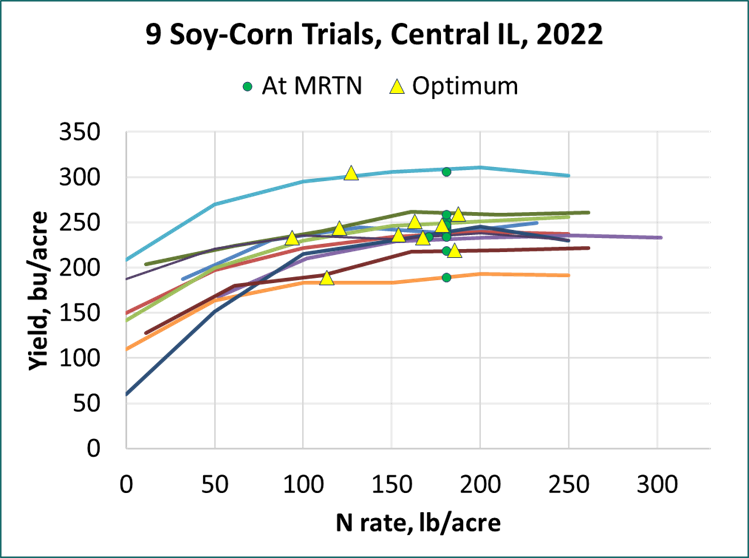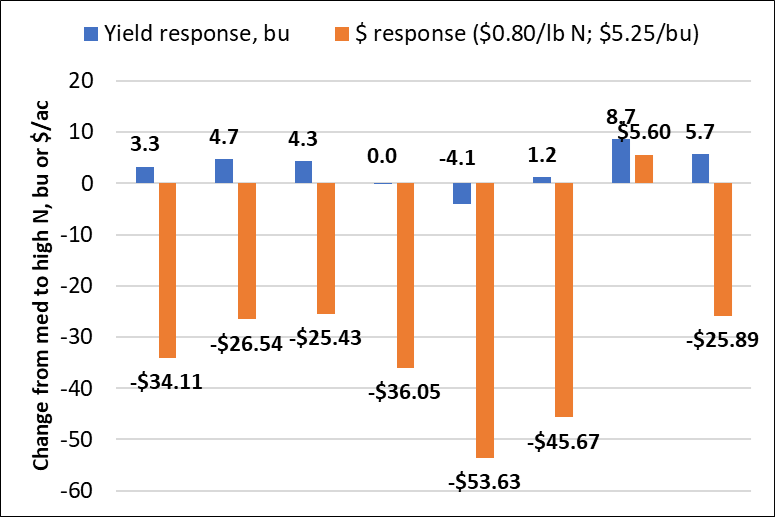Nitrogen for the 2023 Corn Crop
Helped more than hurt overall by periods of dry weather during the season, the 2023 Illinois corn averaged 214 bushels per acre, the highest yield on record. We’ll look at some results from N fertilizer trials in 2022 and consider how we manage N for the upcoming season.
N rate
Figure 1 below shows N responses for corn following soybean in nine N rate trials in central Illinois in 2022. These are drawn using actual data points (yields at each N rate averaged over reps), and curves were generated to identify economic optimum N rates (where the last pound of N adds enough yield to pay for itself, shown as yellow triangles) for each curve, and also yield at the MRTN rate (calculated using the N rate calculator at https://www.cornnratecalc.org/) The MRTN is the same (at a given set of N and corn prices) across central Illinois, so these are in a line vertically.

In almost every case, the actual optimum N was less than the MRTN, meaning that using the MRTN would have supplied more N than the crop needed. We have seen this in a few previous years—2016 is a good example. We typically see this when rainfall during the first half of the season is less than normal. In 2022, dry conditions in June were followed by enough rainfall in July and August to produce good yields, often with less than normal amounts of N fertilizer.
Relatively dry conditions without standing water during vegetative development resulted in very good plant stands, healthy roots that were able to grow downward without interference, a good supply of N from mineralization of soil organic matter, and minimal loss of N applied as fertilizer. Crop canopy color was good, although it paled some in fields that showed afternoon symptoms of drought stress. When rain came in July and August, water uptake resumed, and plenty of N moved into the plants with this water.
We did hear of a few cases in which the outstanding appearance of the corn crop led producers to apply more N, in keeping with the idea that realizing high yield potential requires additional N. That certainly was not the case in 2022: soils had more N present and available than they normally do during the 2022 season, and adding more did nothing to increase yield. We know from past experience that very wet conditions during June can increase the need for N, both because of N loss due to denitrification and leaching, and also because roots do not function very well in wet soils. The lesson: consider adding more N when soils are wet early, but not when June rainfall is normal or less than normal.
With dry surface soils, N applied as surface-banded (Y-drop) UAN or broadcast urea may not have reached the roots for plant uptake until rain fell, which in some cases may have been two weeks or more. Some of this N might have been lost through volatilization, even if urease inhibitor was used. In many cases, though, N applied at normal sidedress time may not have been necessary given that fertilizer N needs were relatively low. The only exception to that might have been when more than half of the crop’s N was reserved to apply at sidedress, in which case the crop might not have gotten enough N until it was too late to make full use of it.
Two-rate N trials
With funding from the Illinois Nutrient Research & Education Council (NREC), IFCA and we at the UI are starting a project to see how yield responds to increasing or lowering N rates producers are already using. Optimum N rates are located on a response curve where changing the rate does not change yield very much: if 10 lb of N has the same dollar value as a bushel of corn, then the last 10 lb of N up to the optimum adds 1 bushel of corn, and adding 10 lb of N more than the optimum adds less than 1 bushel. The idea with this project is to demonstrate that yield at normal N rates is not changed much by adding more N. In cases where yield changes more than expected when the N rate is raised or lowered, we hope to learn why that happens, and maybe how we could adjust N rates in the future.
Figure 2 shows yield changes and economic returns in eight two-rate trials in central and southern Illinois in 2022. The average medium rate across these trials was 185 lb N/acre, and the average high rate was 242 lb N/acre. Adding 57 lb N/acre produced an average of 3 bushels more yield, and with N at $0.80 per lb and corn at $5.25 per bushel, the net result was a loss of a little more than $30 per acre from adding the additional N. The return was positive at only one site, in southern Illinois.

The MRTN generated by the N rate calculator includes the total amount of N to be applied for the crop, including N from MAP or DAP. Using a fall 2023 corn price of $5.25 and a spring N price of $0.80/lb of N ($512 per ton of 32% UAN) produces MRTN values for corn following soybean of 155 lb N/acre in northern Illinois, 165 lb N/acre in central Illinois, and 183 lb N/acre in southern Illinois. Rates for corn following corn are 183 lb N/acre in northern and 181 lb N/acre in central Illinois. The ends of the “profitable range” for each of these rates are about ±10 lb of N. Rates will change if the ratio between N price and corn price change by the time the last N is applied. For the MRTN calculation, use the price of the last form of N applied: all N applied before that represents a sunk cost that can’t be adjusted. If you find that more than the MRTN rate has already been applied before the last application is scheduled, it may make sense not to make the last application, especially if the crop is growing well, soils moisture supplies are good, and canopy color is good.
N application
Most corn in Illinois in 2022 was planted during the middle two weeks of May, when soils were warming up. Mineralization was kicking in by the time the plants emerged, and we saw little early N deficiency that sometimes shows up when soils are cold at emergence. With N mostly staying where it was placed in the soil, and with roots that grew well in soils over the weeks after planting, there were few issues with N uptake in 2022. This continued to be the case, except for temporary N deficiencies in dry areas as noted above.
In one study of N (UAN) timing and placement in 2022 at Urbana, we found no yield response to any of the treatments—including row surface banding versus injection between rows, and all early versus split-sidedress—used to apply 150 lb N. The optimum N rate in the rate portion of this study was only 111 lb N/acre. With the crop needing nearly 40 lb of N less than the rate applied, it’s not surprising that different placement and timing treatments produced no yield differences. With most Illinois fields receiving more N than the crop actually needed in 2022, most ways of applying N probably worked very well.
We need to keep in mind that the corn crop needs access to N near the row as the nodal roots emerge at around stage V2-V3. This can be applied at any time and using any form, as long as the N is present when it’s needed. Warm soils at planting will help make this happen, but cold soils and, perhaps, the presence of cereal rye cover crop residue near the row, may lower the amount of N in the soil, and could lead to lowering the yield potential.
Inhibitors
An ongoing question is whether or not to use N stabilizers or inhibitors with spring-applied N. If ammonia is applied more than a few weeks before planting, after soils begin to warm up, using a nitrification inhibitor (N-Serve®, Centuro®) might be justified as protection against loss of nitrate if it turns wet after planting. UAN applied at or right before planting that is incorporated by injection or tillage is generally safe from loss, as is broadcast UAN that is followed by a half-inch or so of rain within a week or 10 days after application. Cool temperatures act to inhibit microbial conversions as well, and temperature can be taken into account when deciding whether or not to use inhibitors.
Nitrogen from sidedressed N needs to get to the roots in order to be effective, and inhibitors should not delay this process. Sidedress ammonia kills off some soil microbes that carry out nitrification, and while that effect is quickly reversed as N stimulates new microbial growth, using a nitrification inhibitor to delay nitrification can delay the process of N reaching the roots. Some research has shown that yield losses can result from such delays. UAN injected between the rows does not need a urease inhibitor to protect against volatilization, and in warm soils, generally does not benefit from having the conversion of ammonium (from urea and ammonium nitrate) delayed by an inhibitor.
It’s a little tougher to make the call on inhibitor use if UAN is surface-banded/dribbled. Rain within a week after application will move the N into the soil quickly, making it relatively safe from loss. If it stays dry for two weeks, then a urease inhibitor might prevent some volatilization loss. Broadcast urea has the same issue, and with all of its N needing to be converted to ammonium and then to nitrate in order to move, both urease and nitrification inhibitors (SuperU® has both) might be beneficial if the weather stays dry for weeks after application. Using both inhibitors raises the cost of N, and N loss potential has to be relatively high in order to make this cost-effective.
Other additives
Various chemical and biological agents are on the market as ways to increase crop yields, to protect against nutrient loss, and to increase nutrient uptake and use efficiency. There is not a lot of publicly-available research on many of these products. Some of the more recent ones to come on the market are products that contain microbes—usually bacteria—that are said to stimulate root or plant growth, and to increase nutrient uptake. Some seed treatments for corn contain some of these already, while others are still being developed and marketed.
The microbes in some of these products are bacteria said to be able to fix N for the corn crop, either increasing yield at normal N rates or maintaining yield while allowing fertilizer N rates to be lowered. Although research we have seen so far does not make a strong case in favor of these products, it is never possible to prove that any given product “doesn’t work” or, for that matter, does “work,”
It is possible to test such products, but we need to take care to make a proper comparison. For example, if a product is sold as a replacement for fertilizer N—that is, the N rate can be reduced if the product is added—the trial needs to be set up with the reduced-rate strip wide enough to include both an untreated and treated strip. We know (as the two-rate trials reported above show) that lowering an already-high N rate (more than 230 or 240 lb N/acre) by 40 lb is unlikely to lower yield by much, if any. This means that, if the lower N rate with the product yields the same as the higher N rate without it—this would be considered a “win”—we have no idea whether the product contributed anything. The only way to know is to use the lower N rate without the product.





